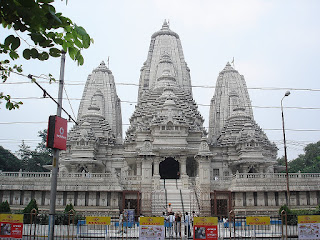While reading “Recess: The Penguin Book of Schooldays” (Penguin Books; Edited by Palash Krishna Mehortra; ISBN 978-0-14-310011-9), I came across some curious portions which touch internal conflicts within Indian society during growing years of Christianity:
1. … Calcutta in 1834 when I came to that city from my native village. There were then four principle schools – the Hindu College; the General Assembly’s Institution, always called Duff’s School; the School Society’s School, called Hare’s School; and the Oriental Seminary, usually called Gour Mohana Addhya’s School. The question with my father was – into which of these schools should I be put? … There remained then the General Assembly’s Institution, where admission was given generously…
But, then, there was one serious drawback. Dr. Duff (he was then simply Mr. Duff) was a most zealous Missionary. He made no secret of it, but publicly avowed, that his chief object in setting up the Institution was to initiate Hindu youth into the principles of the Christian religion. He had already appeared as a Public Lecturer on Christianity, and his Lectures had taken Calcutta by storm. Those Lectures had not only created a great sensation in the Hindu community, but had brought to the Christian faith some of the brightest and most intelligent youth of the city. Only a year and half before, Dr. Duff had baptized Krishna Mohana Banerjea (now the Reverend K. M. Banerjea); and the conversion of Krishna Banda – as he was then universally called – had produced a tremendous impression on the Hindu community.
“Is it right – is it expedient,” argued some of my father’s friends, “to imperil the religion of your son by putting him for education into the hands of so zealous a Missionary, of a man whose avowed object is to eat the religion of young Hindus, of a man who has already succeeded in eating the religion of several young men?”…
(From Lal Behari Dey, Bengal Peasant Life, Folk Tales of Bengal, Recollections of My School-days (1876), edited by Mahadevprasad Saha, Calcutta: Editions Indian, 1969)
---
2. The Mission School and the Girls’ School were housed in a large bungalow, and were separated by a wall. Only Christians studied in the Girls’ School. The fear of losing caste was so great among the Hindus that they would not send their daughters to school.
(From Fakir Mohan Senapati, Story of My Life (1918, published in 1927), translated from the Oriya by Jatindra K. Nayak and Prodeepta Das, Bhubneshwar: Sateertha Publications, 1997.)
---
3. “What an annoying fellow that old teacher is, to be sure. If it were not for the English I wouldn’t tolerate him a bit. I had a good mind to give it to him this day. What does he mean by always dinning into our ears the Bible, as if we had no Shastras of our own? I told him today, when he took me aside and spoke to me in serious tones about my spiritual condition, to learn a little more of our Shastras. What can compare with our grand old Vedic religion and our scriptures?”
“That is right T…! Make the old fellow a convert to our religion,” says an old dame jocularly. “We will give him some marks on his forehead and besmear him with ashes. He will be a perfect Brahmin.”
“Ha! ha! ha!” laugh all the females, while the males put their heads down and deign to smile inwardly and wear a pleased expression.
“The polluted old one, how dare he speak of the religion of the pariahs to you, my dear son! I greatly fear him,” says the mother.
“No need of fear, mother! He will be a convert first before I become one. I am quite a match for him and can hold my own. I tolerate him and the school only for the English. Do you mean to say I like him?”
The father chuckles in silence. The meal ends and the son majestically stalks out with a heap of books under his arm. The father says to the women with a wink in the direction of the young man, meant to express a sort of a self-satisfied pride. “Leave him to himself. He knows how to manage the old fanatic. Be sure he will come out scatheless. He is no ordinary lad.”
(From Krupabai Satthianadhan, ‘The Story of a Conversion’, in The Satthianandhan Family Album, Edited with an Introduction by Eunice de Souza, New Delhi: Sahitya Akademi, 2005.)
---
4. Ours was a Lutheran Mission School – mostly for boarders who were Christian converts. The teachers were all converts, and, towards the few non-Christian students like me, they displayed a lot of hatred. Most of the Christian students also detested us. The scripture classes were mostly devoted to attacking and lampooning the Hindu gods, and violent abuses were heaped on idol worshippers as a prelude to glorify Jesus. Among the non-Christians in our class I was the only Brahmin boy, and received special attention; the whole class would turn in my direction when then teacher said that Brahmins claiming to be vegetarians ate fish and meat in secret, in a sneaky way, and were responsible for the soaring price of those commodities.
(From My Days, R. K. Narayan)
---







